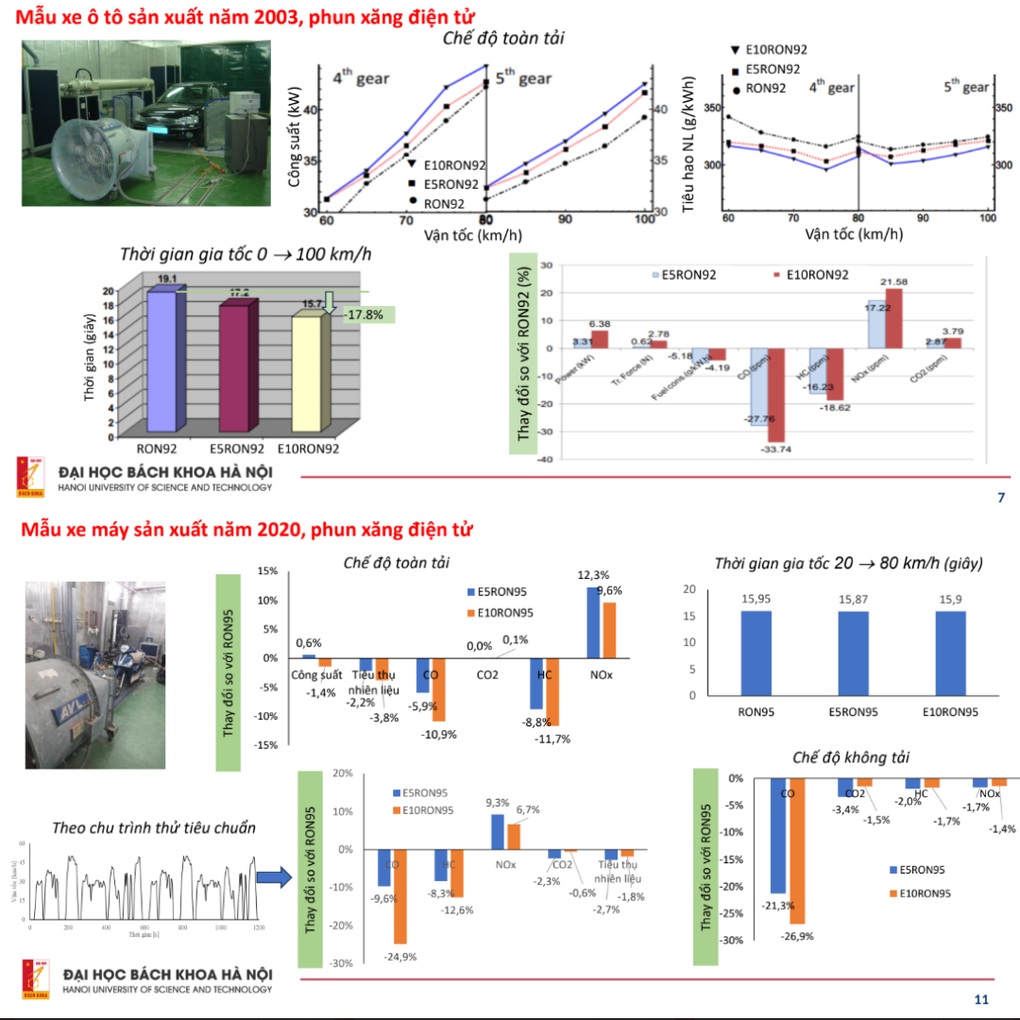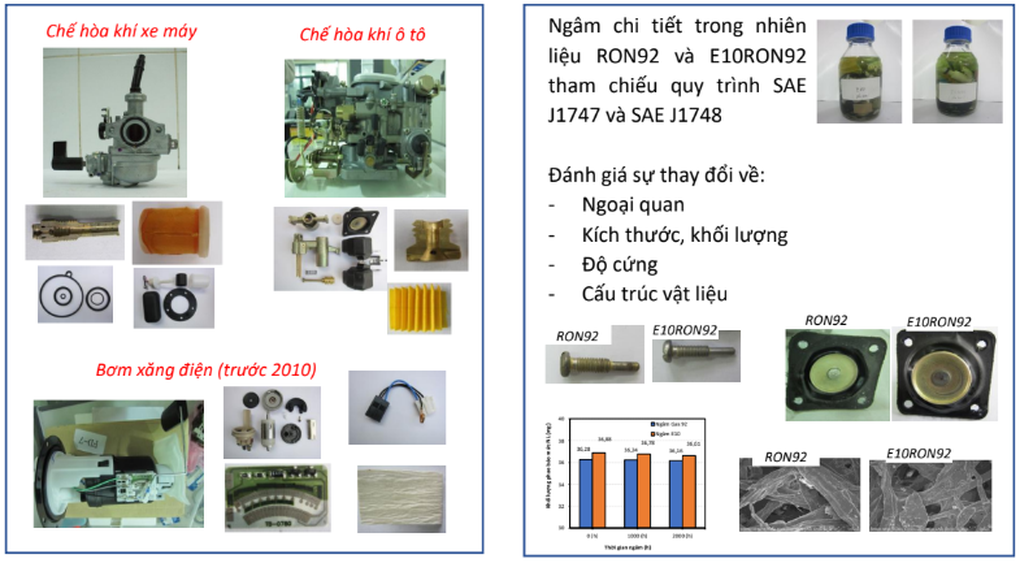At the recent workshop on biofuel development organized by the Ministry of Industry and Trade , Associate Professor Dr. Pham Huu Tuyen, Director of the Center for Research on Power Sources and Self-Propelled Vehicles (Hanoi University of Science and Technology) announced some research results on the effectiveness of E5 and E10 biofuel for automobile and motorbike engines in Vietnam.
He said the research team conducted the study from 2010-2011 using a comparative evaluation method, with the same operating conditions but changing the fuel type (mineral gasoline, E5, E10), with evaluation criteria including capacity, torque, fuel consumption and emissions.
Cars using E10 gasoline accelerate faster than mineral gasoline
According to research on cars manufactured in 2001 (electronic fuel injection), the results show that power and fuel consumption are almost similar between RON 92 and E10 RON 92 gasoline.
Notably, when using E10 RON 92 gasoline, engine capacity increased by 1.6%, fuel consumption decreased by 0.81%, HC and CO emissions decreased by 6.6% and 6.09% respectively compared to RON 92 mineral gasoline.
With the 2003 car model (electronic fuel injection), the acceleration ability is significantly improved. When using E10 RON 92 gasoline, the acceleration time from 0 to 100km/h takes only 15.7 seconds, while with RON 92 mineral gasoline it is 19.1 seconds. Recently, testing on cars manufactured in 2015 with RON 95 and E10 RON 95 also showed similar results, the car starts easily, there is no significant difference between fuel types.

Test results on a 2003 car and a 2020 motorbike (Photo: Screenshot).
The study was also conducted on 1999 motorcycles (carburetor) and the results were similar to those of cars. On a 2020 motorcycle model (electronic fuel injection), the acceleration time from 20 to 80 km/h when using E10 RON 95 gasoline was 15.9 seconds, almost no different from that of RON 95 gasoline (15.95 seconds).
However, at full load (engine running at maximum throttle, maximum power - PV), motorbikes running on E10 RON 95 gasoline have a 1.4% reduction in power compared to motorbikes running on RON 95; but fuel consumption is reduced by 3.8%... In addition, testing on 12 car models and 9 motorbike models of different generations shows that when using E10 RON 95, CO, HC and NO emissions are all significantly reduced compared to mineral gasoline.
Rubber and copper parts in older cars can be affected when using E10 gasoline.
Mr. Tuyen said that this unit also tested the durability of old generation cars and motorbikes when using RON 92 and E10 RON 92. The subjects included 2 motorbikes from 1999 (carburetor, run 20,000km), 2 engines from 1995 (carburetor, tested 300 hours) and 6 cars manufactured before 2003 (carburetor, electronic fuel injection, run 20,000km).
Evaluation indicators include piston and cylinder wear, power changes, fuel consumption, emissions and lubricating oil quality.
The results show that the level of wear and tear and parameter degradation when using RON 92 and E10 RON 92 are equivalent, both within the allowable limit, although the impact of E10 RON 92 is more obvious. For new generation vehicles, the manufacturer has confirmed that it is compatible with E10 gasoline.

The effect of E10 RON 92 gasoline on some rubber parts in the carburetor's accelerator pump changed more clearly than when immersed in regular mineral gasoline (Photo: Screenshot).
The study also immersed parts in old fuel systems (such as carburetors of motorbikes, cars and electronic fuel pumps manufactured before 2010) in RON 92 gasoline and E10 RON 92, according to the testing procedures of the American Society of Automotive Engineers (SAE J1747 and SAE J1748).
"The results showed that the parts before and after being soaked in RON 92 and E10 RON 92 changed, especially the copper and rubber parts were deformed. The effect of E10 RON 92 gasoline on some rubber parts in the carburetor's accelerator pump changed more clearly than when soaked in regular mineral gasoline," said Mr. Tuyen.
Associate Professor Dr. Pham Huu Tuyen affirmed that the effectiveness of E10 gasoline on vehicles such as cars and motorbikes generally has a positive impact on technical features such as improving capacity and reducing fuel consumption.
In addition, using E10 gasoline also reduces toxic CO and HC components in exhaust gas, because ethanol (used to blend E10) is biologically derived, renewable and reduces CO2 emissions.
"From our research and research around the world , it shows that E10 gasoline is suitable for most vehicles in circulation, but may have certain effects on older generation vehicles using carburetor technology," he said.
The expert said that car and motorbike manufacturers and importers in Vietnam should publish a list of car models compatible with E10 gasoline, with recommendations if necessary.
Source: https://dantri.com.vn/kinh-doanh/ket-qua-nghien-cuu-vua-cong-bo-xang-e10-tac-dong-sao-toi-o-to-xe-may-20250830000820225.htm


![[Photo] Parade to celebrate the 50th anniversary of Laos' National Day](/_next/image?url=https%3A%2F%2Fvphoto.vietnam.vn%2Fthumb%2F1200x675%2Fvietnam%2Fresource%2FIMAGE%2F2025%2F12%2F02%2F1764691918289_ndo_br_0-jpg.webp&w=3840&q=75)



![[Photo] Worshiping the Tuyet Son statue - a nearly 400-year-old treasure at Keo Pagoda](/_next/image?url=https%3A%2F%2Fvphoto.vietnam.vn%2Fthumb%2F1200x675%2Fvietnam%2Fresource%2FIMAGE%2F2025%2F12%2F02%2F1764679323086_ndo_br_tempimageomw0hi-4884-jpg.webp&w=3840&q=75)




































































































Comment (0)